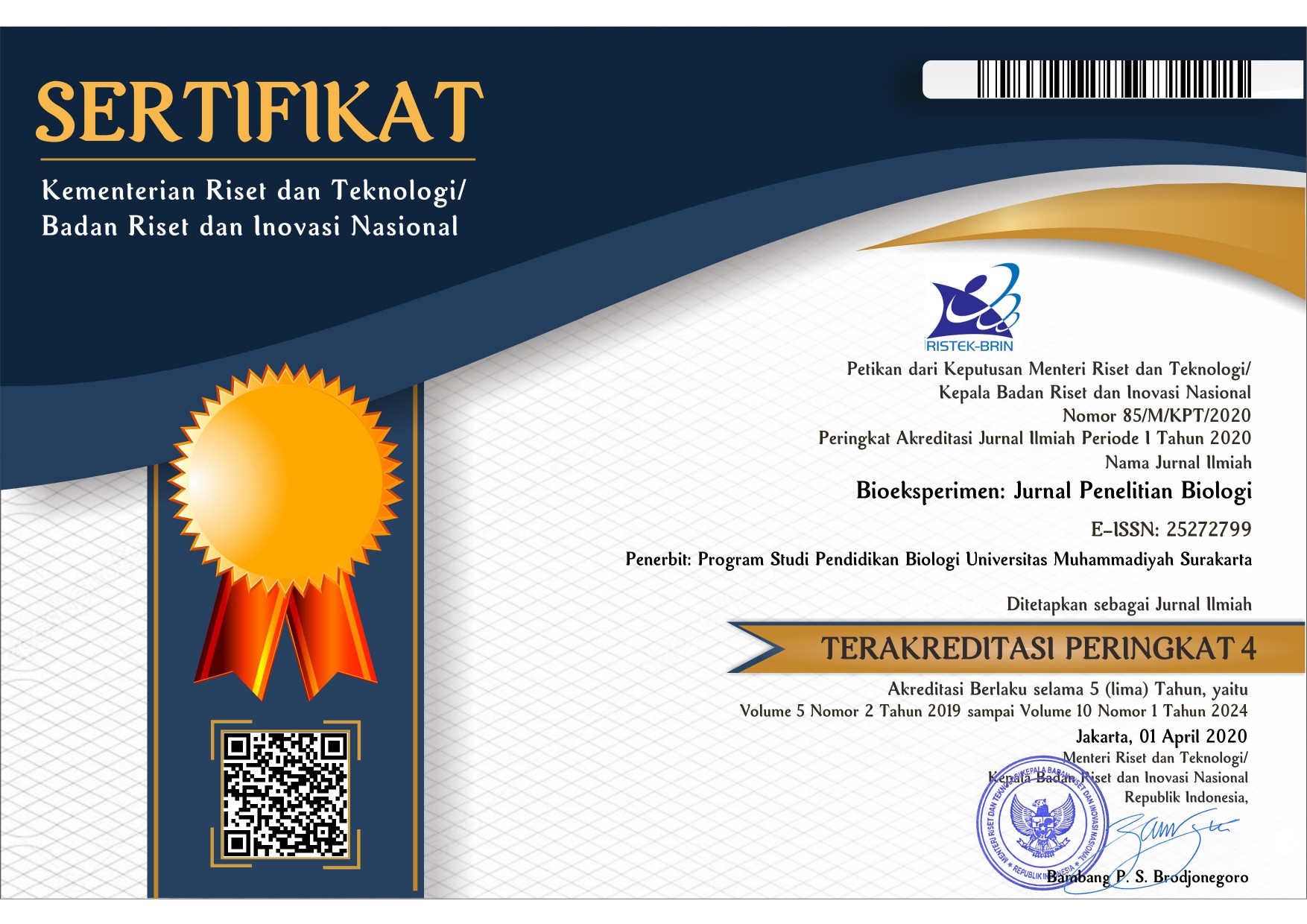Isolation and Molecular Identification of Indole Acetic Acid-Producing Endophytic Bacteria from Daun Dewa Plant (Gynura divaricata (L.) DC)
Ratna Dewi Setyowati(1*), Artini Pangastuti(2), Ari Susilowati(3)(1) Bioscience Study Program, Graduate Program, Universitas Sebelas Maret, Jl. Ir. Sutami 36 A, Kentingan, Surakarta, 57126
(2) Bioscience Study Program, Graduate Program, Universitas Sebelas Maret, Jl. Ir. Sutami 36 A, Kentingan, Surakarta, 57126
(3) Bioscience Study Program, Graduate Program, Universitas Sebelas Maret, Jl. Ir. Sutami 36 A, Kentingan, Surakarta, 57126
(*) Corresponding Author
Abstract
Indole acetic acid (IAA) is an auxin hormone that can regulate plant growth and development. Bacteria produce IAA through L-tryptophan metabolism. The purpose of this study was to determine the ability of endophytic bacteria isolated from Daun Dewa plants to produce IAA to increase the germination and growth of tomato seedlings. Isolation of endophytic bacteria was carried out by sterilizing plant surfaces. The production of IAA is done by adding L-tryptophan precursors. The results showed that there were six endophytic bacteria, and three isolates of them have the potential to produce IAA, namely: AD1.1, UD1.1, and UD2.1. The highest IAA concentration was produced by isolate AD1.1. Growth in sprouts is significantly influenced by the concentration of IAA; the higher the concentration of IAA, the longer the shoots and the roots. Based on the 16S rRNA gene sequence, these isolates belong to the genus Klebsiella.
Keywords
Full Text:
PDFReferences
A,G. Moat, J.W. Foster, and .P. Spector. 2007. Micrbial Physiology. Fourth Edition. New York: Wiely-liss. Inc
Berkum,V.P. and B.B.BOHLOOL.1980. Evaluation of nitrogen fixation by bacteria in association with roots of tropcal grasses. Microbiol Rev. 44 (3): 491-517
Bernadus, T dan W. Wahyu. 2002. Bertanam Tomat. Agromedia Pustaka. Jakarta.
Bhattacharyya PN, Jha DK(2012)Plant growth-promoting rhizobacteria (PGPR): emergence in agriculture.World Journal of Microbiology & Biotechnology.28:1327 –1350.
Bianco C, Imperlini E, Calogero R, Senatore B, Pucci P, Defez R. 2006. Indole-3-acetic acid regulates the central metabolic pathways in Escherichia coli. Microbiology 152: 2421-2431
Chen M, Lin L, Zhang Y, Sun L, An Q. 2013. Genome sequence of Klebsiella oxytoca SA2, an endophytic nitrogen-fixing bacterium isolated from the pioneer grass Psammochloa villosa. Genome Announc. 1(4):e00601–13.
Davies PJ. 2004. The plant hormonrs: Their nature, occurrence and function, In : Davies pj (ED) Plant Hormones: Biosyntetis, Signal Transduction, Action. Kluwer Academic Publisher, Dordrecht, The Netherlands, pp 1-15
Gravel V, Antoun H, Tweddell RJ (2007) Growth stimulation and fruit yield improvement of greenhouse tomato plants by inoculation with Pseudomonas putida or Trichoderma atrovi-ride: possible role of indole acetic acid (IAA). Soil Biol Biochem 39: 1968-1977
Grobelak A, Napora A, Kacprzak M (2015) Using plant growth-promoting rhizobacteria (PGPR) to improve plant growth. Ecol Eng 84: 22-28
Jasim B, Joseph Agnes Aswathy, Jimtha John C, Mathew J, Radhakrishnan EK (2014). 2014 Isolation and Characterization of Plant Growth Promoting Endophytic Bacteria from The Rhizome of Zingiber officinale. Biotech 4: 197-204
Khan, M. S., Zaidi,A., Ahemad, M., Oves, M.,& Wani, P.A. (2010). Plant Growth Promoting by Phosphate Solubilizing Fungi-Current perspective. Archives of Agronomy and Soil Science, 56(1): 73-98
Rosenblueth, M and E. Martínez-Romero. 2006. The American Phytopathological Society. MPMI Vol. 19, No. 8 :827–837
Rui S. Oliveira, Ines Rocha, Ying Ma; Miroslav Vosatka & Helena Freitas. 2016. Seed coating with arbuscular mycorrhizal fungi as an ecotechnologicalapproach for sustainable agricultural production of common wheat (Triticum aestivum L.). Journal of Taxicology and Environmental Health, Part A.
Taiz I, Zeiger E. 2002. Plant Physiology Third Edition Sunderland: Sinaeur Associates Inc.
Marchesi JR, Sato T, Weighman AJ, Martin TA, Fry JC, Himpm SJ, Wade WG. 1998. Design and evaluation of useful bacterium specific PCR primer that amplify genes coding for bacterial 16S rRNA. Appl. Environ Microbiol 63: 795-764.
Marag, Shivsing., Premsing & Suman, Archana. 2018. Growth stage and tissue specific colonization of endophytic bacteria having plant growth promoting traits in hybrid and comosite maize (Zea mays L.). Microbiological Research 214: 101-113
Matsuda F, Miyazawa H, Wakasa K. (2005). Quantification of Indole-3-acetic and Amino Acid Conjugates in Rice By Liquid Chromatography-Electrospray Ionization Tandem Mass Spectrometry. Biosci Biotechol Biochem: 69: 778-783.
Sachdev DP, Chaudhari HG, Kasture VM, Dhavale DD, ChopadeA(2009)Isolation and characterization of indole acetic acid (IAA) producing Klebsiella pneumoniae strains from rhizosphere of wheat (Triticum aestivum) and their effect on plant growth.Indian Journal of Experimental Biology.47:993 –1000.
Spaepen S, Vanderleyden J, Remans R (2007) Indole-3-acetic acid in microbial and microorganism-plant Signaling. FEMS Microbiol Rev 31: 1-24
Silva, H. S. A., R. S. R. Romeiro, D. Macagnam, B. A. H. Viera, M. C. B. Pereira, A. Mounteer. 2004. Rhizobacterial induction of systemic resistance in tomato plants: nonspecific protection and increace in enzyme activities. Biol Control 29: 288-295.
Tangapo, Monalisa. 2020. Potensi Bakteri Endofit Ubi Jalar (Ipomoea batatas L.) dalam Menghasilkan Hormon Indole Acetic Acid (IAA) dengan Penambahan L-triptofan. Jurnal Bios Vol. 10 No 1.
Kunkel, B.N., Chen, Z., 2006. Virulence strategies of plant pathogenic bacteria. In: Dworkin, M., et al. (Eds.), The Prokaryotes. A Handbook on the Biology of Bacteria, Ecophysiology and Biochemistry, 3rd ed. pp. 421-440.
Celloto VR, Oliveira AJB, Jose´ EG, Watanabe CSF, Graciette M, Regina ACG (2012) Biosynthesis of indole-3-acetic acid by new klebsiella oxytoca free and immobilized cells on inorganic matrices. Sci World J 2012:7.
Drancourt M, Bollet C, Carlioz A, Martelin R, Gayral JP, Raoult D. 2000. 16S ribosomal DNA sequence analysis of a large collection of environmental and clinical bacterial isolates unidentifiable. J Clin Microbiol 38 (1): 3623-3630.
Article Metrics
Abstract view(s): 465 time(s)PDF: 323 time(s)
Refbacks
- There are currently no refbacks.








